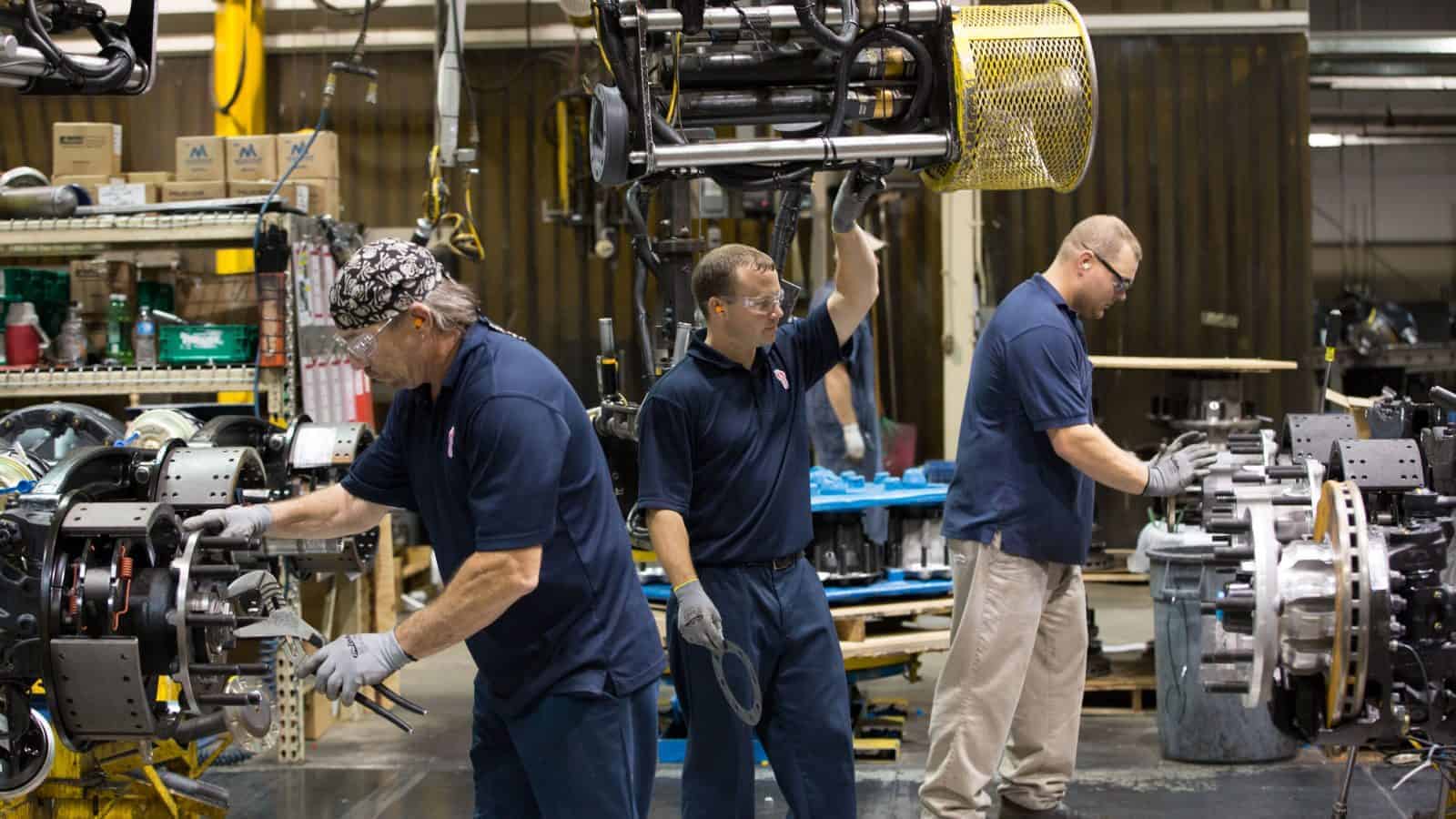Making a Difference: Creators Wanted Visits Charlotte
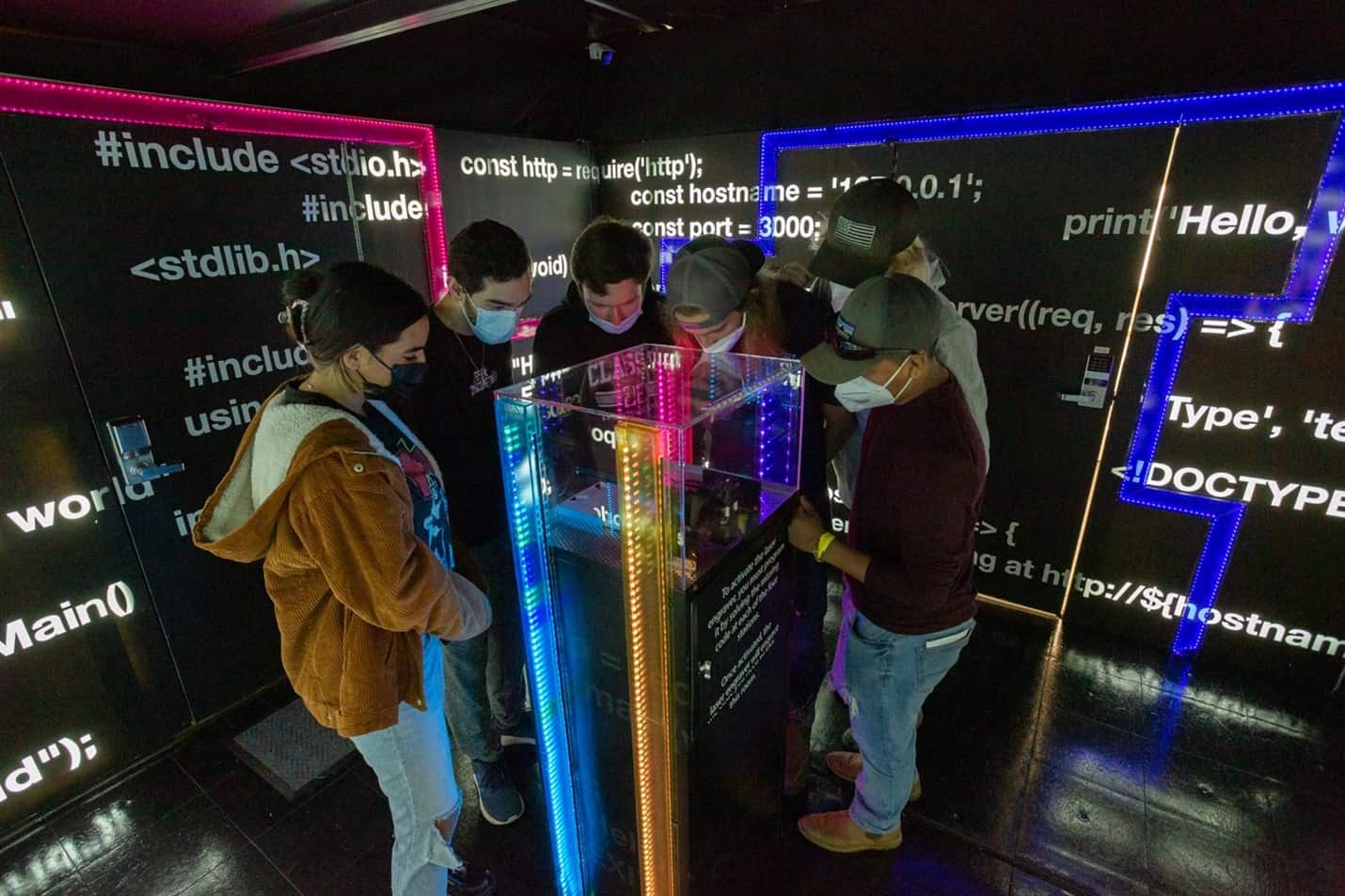
Creators Wanted is having a moment. In Charlotte, North Carolina, the fourth stop of the mobile experience’s five-city expedition around the U.S., the Creators Wanted Tour Live continued to generate big excitement about manufacturing and the career opportunities the industry offers.
“I’m only 22 and I bought a house, a boat and a dirt bike,” said Ketchie Inc. Lathe Department Lead Machinist Zach Whitley, during a nationally aired live Creators Wanted Spotlight conversation with students from East Mecklenburg and Hopewell high schools. “Manufacturing is what has enabled me to have this lifestyle.”
Makers needed—and rewarded: The spotlight event was part of the four-day stay of the mobile experience at Central Piedmont Community College presented by Trane Technologies. The tour, a project of the NAM and its workforce development partner, The Manufacturing Institute, seeks to inspire, educate and empower the next generation of manufacturers—and recruit at least 600,000 new workers to address the manufacturing talent shortage, which is estimated to leave more than 2.1 million jobs unfilled by 2030, according to Deloitte and the MI.
Its message seems to be getting out.
- “I had never heard of manufacturing before” today, Anson High School sophomore Janita Willoughby told Charlotte Channel 9 WSOC-TV reporter Susanna Black. But as it turns out, in a manufacturing career “you’re making a lot of money and you’re doing stuff you like, so that’s a good thing,” she said.
Goings-on galore: In addition to the spotlight event, the student- and job seeker-focused happenings in Charlotte were many and varied. They included:
- A kick-off event featuring talks from speakers including North Carolina Governor Roy Cooper, Creators Wanted Legacy Sponsor Trane Technologies’ Mike Lamach, NAM Board Chair and Trane’s executive chair, Charlotte-Mecklenberg Schools Superintendent Earnest Winston; Community College Chief Academic Officer Heather Hill; MI Executive Director Carolyn Lee; and NAM President and CEO Jay Timmons
- A manufacturing fair with local manufacturers and education partners, highlighting local career opportunities and pathway programs, certifications and degrees for those interested in manufacturing
- Tours by local high school students of the escape room-like Creators Wanted experience
- Q&A sessions in which students had the opportunity to discuss the manufacturing industry and its jobs with real manufacturers
“Something that excites you”: “There’s a common misconception that manufacturing is boring,” Lamach told an audience of students at the Charlotte kick-off event. “What I love about this Creators Wanted tour is how it pulls you [toward] the many different possibilities in manufacturing. There are many different kinds of opportunities to learn and grow, and all kinds of ways to make a difference. I hope you’ll find something that excites you.”
- The Charlotte stop hosted more than 450 students from West Mecklenburg High School, Anson High School, South & West Stanley High Schools, Floyd Johnson Technology Center, East Mecklenburg High School, Hopewell High School, Myers Park High School, Rowan-Salisbury High School, Harding University High School, the Epiphany School of Charlotte and CPCC, generating approximately 68,000 email signups.
Highlights: Video and photos show some of the fun and learning that took place last week.
A Trane Technologies team member talks to student attendees at a Creators Wanted event.
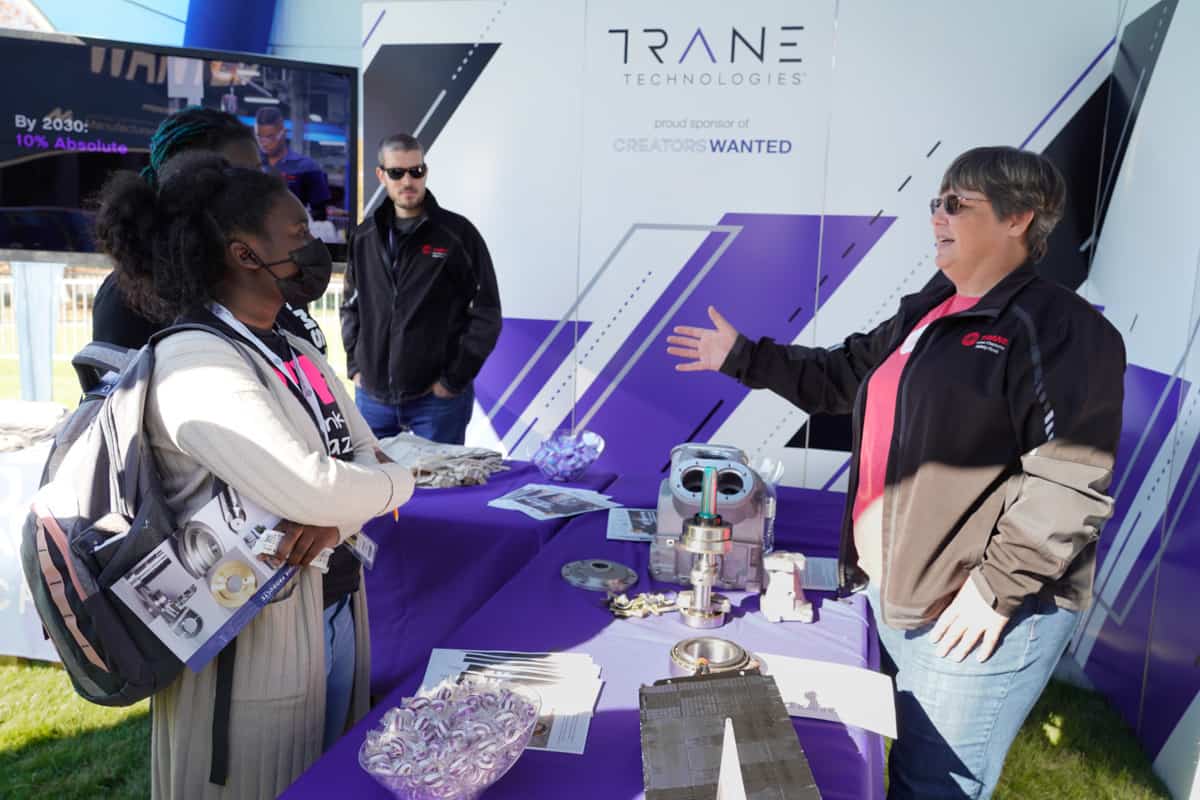
Local high school students and teachers proudly display their escape room times.
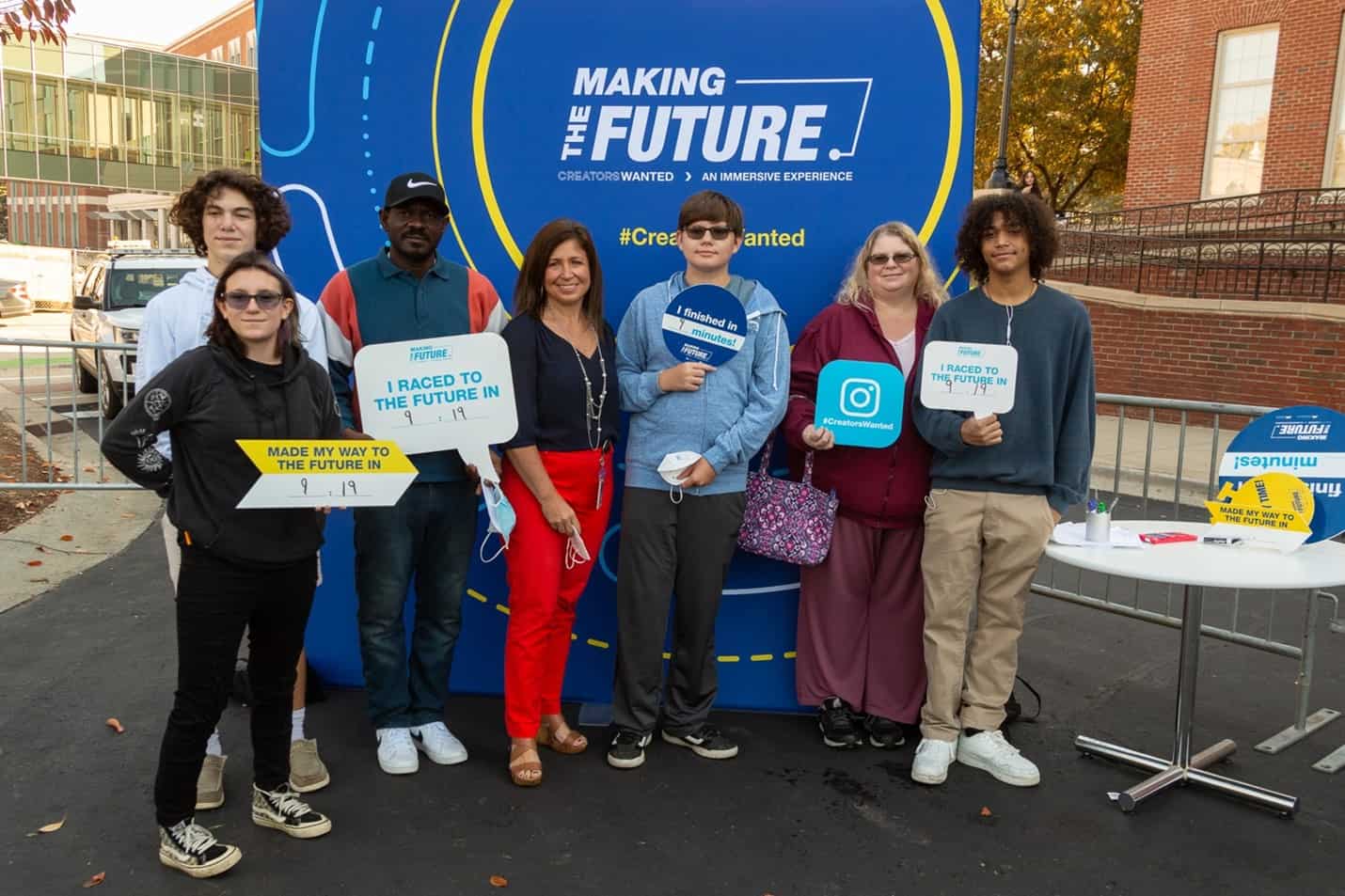
The race to the gateway to the future was on in Honda’s “Sum of All Parts” challenge, where these students made the correct choice as to what product this team of Honda associates is creating.
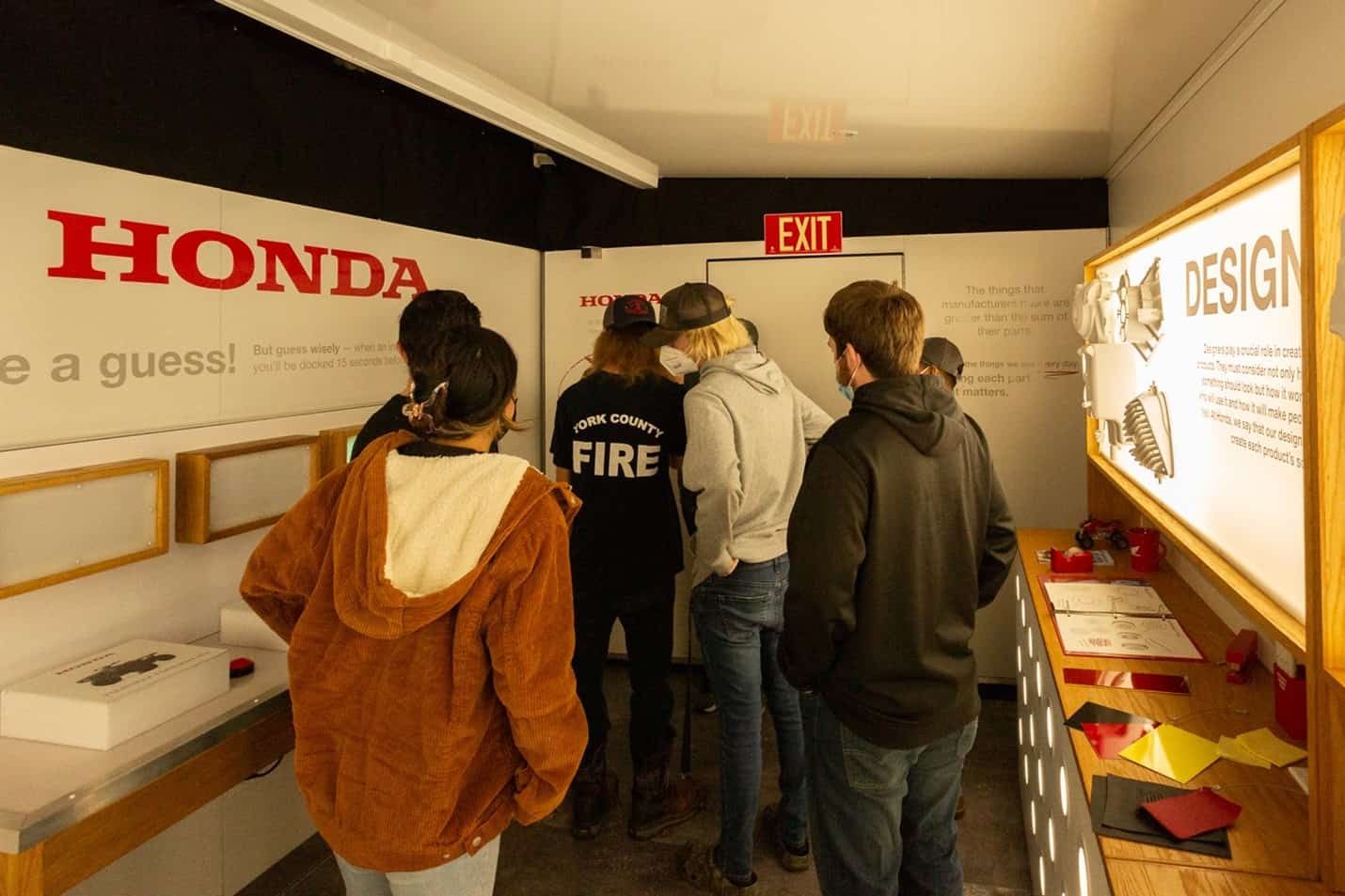
Students had fun working with DJ Enferno to make their own Creators Wanted music anthems, putting more of the creativity central to manufacturing to work.
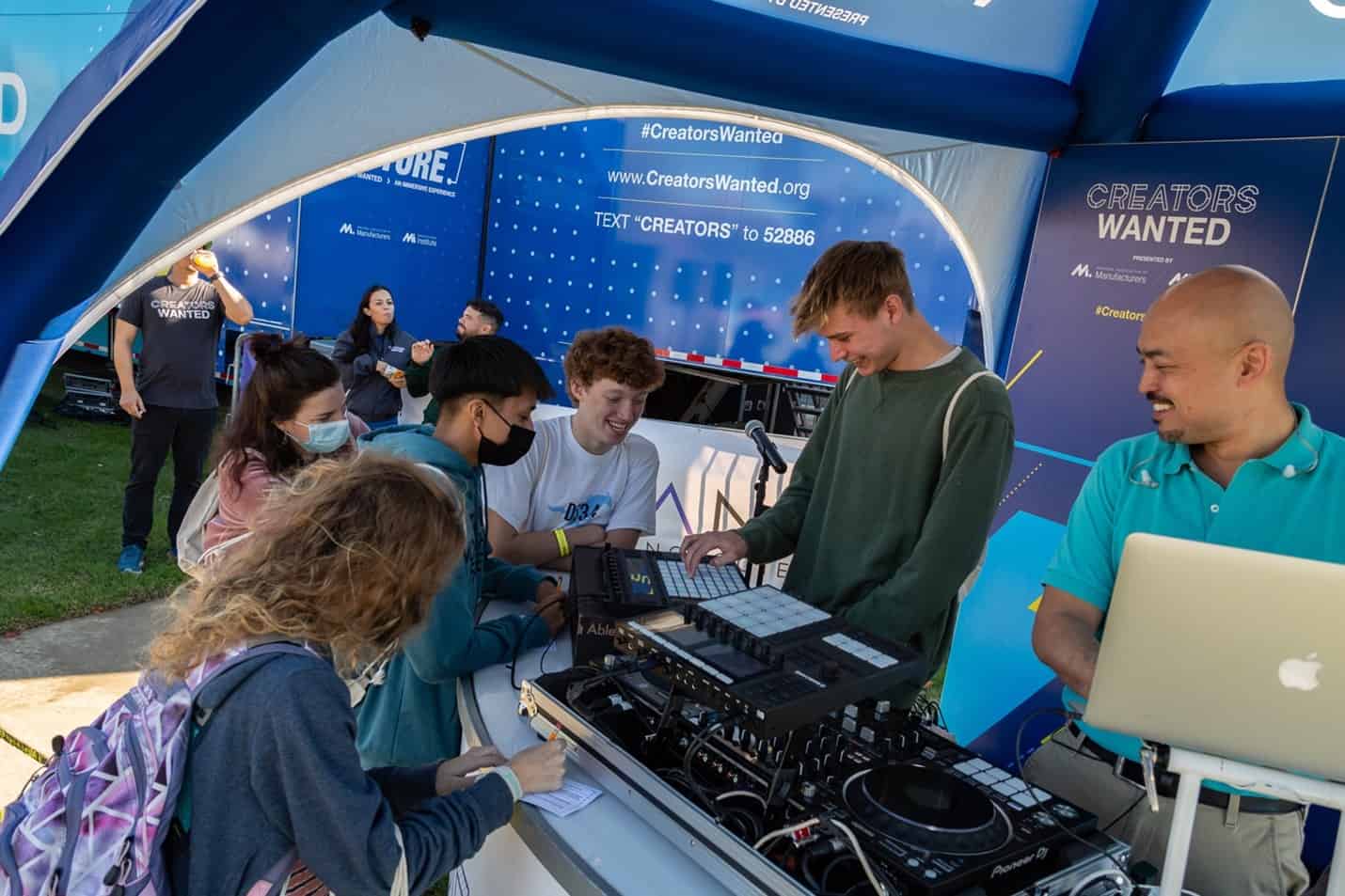
The tour in Charlotte brought manufacturing’s promise to students with differing abilities. Teachers reacted positively to the impact of the experience.
Lamach, whose leadership on Creators Wanted helped get the campaign off the ground, took the stage to emphasize what the tour is all about: students.
The response: Creators Wanted earned notice from some well-known names, both in North Carolina and elsewhere.
Welcome @ShopfloorNAM & @theMFGInstitute's #CreatorsWanted Tour Live to Charlotte!
Manufacturers are in Charlotte this week at @cpcc to fill jobs with the next generation of creators.
If you're interested or need more information on jobs available visit https://t.co/KVraeP2I0T https://t.co/vC5S4y4XBY
— Senator Thom Tillis (@SenThomTillis) November 17, 2021
Group hopes to recruit high school students to join manufacturing jobs https://t.co/SlVccG81ta
— Joe Bruno (@JoeBrunoWSOC9) November 17, 2021
Central Piedmont is proud to host the Creators Wanted tour this week!
Creators Wanted is a mobile experience designed to bring the story of modern manufacturing to communities across the country and promote employment within the industry.
Learn more: https://t.co/9j6ZTEac4A
— Central Piedmont Community College (@cpcc) November 16, 2021
Media mentions: In addition to WSOC-TV, broadcast and online news outlets including the Charlotte Business Journal, WCCB Charlotte and Business North Carolina also covered the Creators Wanted Charlotte stop.
The final say: “You can’t create the future unless you’re engaging the future,” said Chrys Kefalas, chief strategist of the tour and vice president of brand strategy at the NAM. “Students came to us not thinking about manufacturing as a career and left aspiring to careers in the industry. Resumes were handed to manufacturers. We’re creating lasting memories that won’t just result in new workers but [will] also change lives.”
NAM Launches Manufacturers Retirement & Savings Plan
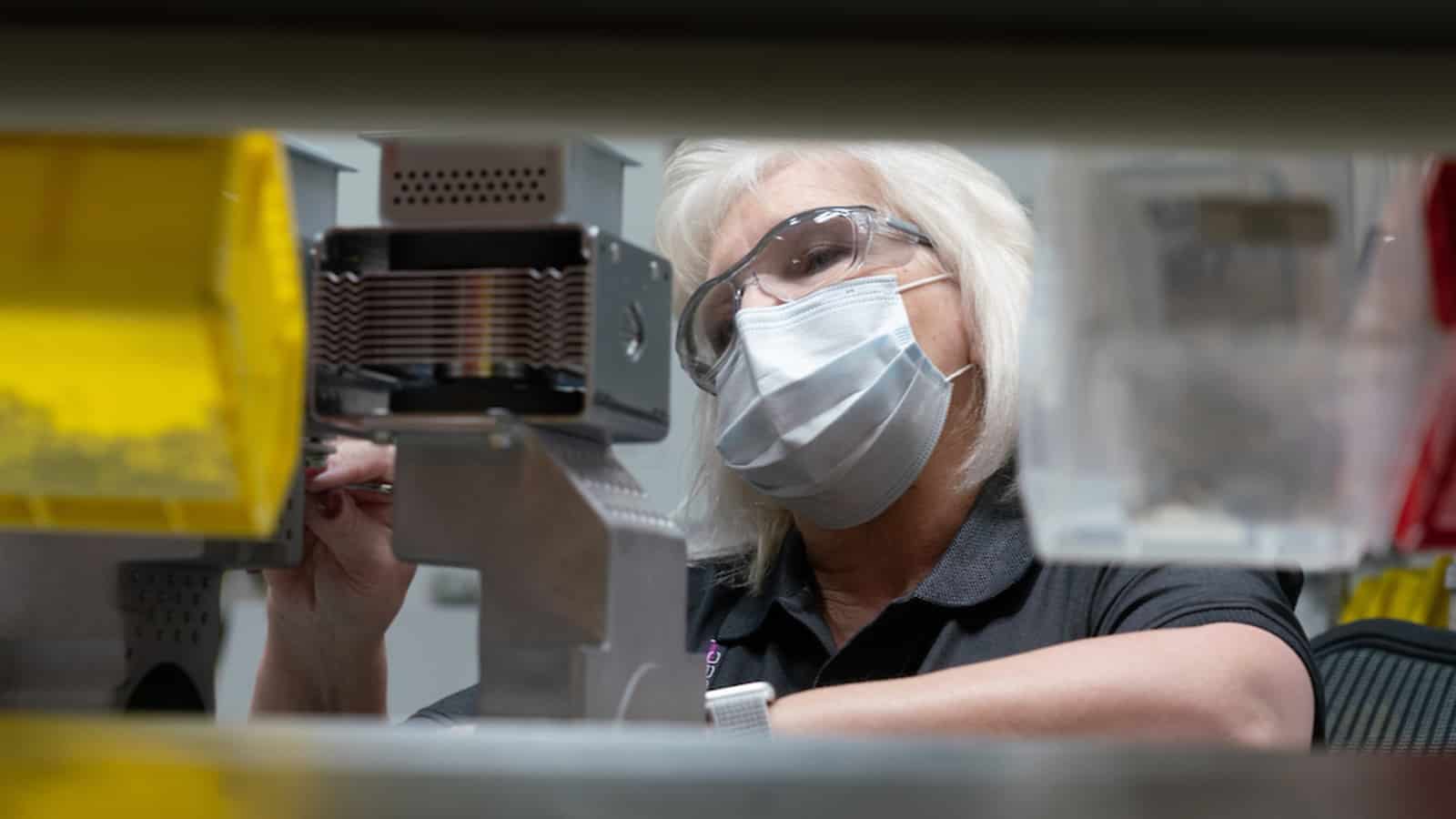
Are you looking for a retirement plan that fits your needs and workforce? There’s good news: the NAM is rolling out the Manufacturers Retirement & Savings Plan—a 401(k) plan designed specifically for manufacturers across the country.
The scope: The Manufacturers Retirement & Savings Plan is a multiple employer plan available to all NAM members, designed to cover more than 14,000 companies and associations. Companies of all sizes can participate, creating new financial opportunities and offering retirement security to the millions of men and women who make things in America.
The provider: The NAM selected Principal Financial Group® and HUB International LLC as the service providers. Principal Financial Group® is one of the largest retirement solutions providers in the United States, and HUB International is a leading North American insurance brokerage. Together, they will offer business owners and employees access to dedicated professionals who can offer guidance and assist with the day-to-day management of retirement plans.
The benefit: Offering benefits like 401(k) plans is a critical way for manufacturers to attract and retain talented employees, especially at a time of unprecedented job openings. But creating and operating a retirement plan can be expensive and time-consuming, imposing barriers for small and medium-sized companies. By creating an association-sponsored plan, the NAM is helping members across the board ensure efficiency, reduce risks and manage costs effectively all while improving retirement outcomes for employees and helping employers free up time and money. And with National Benefit Services engaged to administer the new plan, transitioning is simple as well.
What we’re saying: “Manufacturers want their employees to feel safe and secure about their financial well-being and to have confidence that they will be able to retire when they are ready,” said NAM President and CEO Jay Timmons. “But operating a 401(k) plan can be challenging—especially for smaller companies. We can help with this—I’m proud that the NAM now offers our members access to best-in-class benefits for their teams.”
Learn more: Join us at one of two upcoming information sessions, Nov. 9, 2021 or Dec. 7, 2021.
MFG Day 21 Commences in Person and Virtually Amid Record Career Opportunities in the Manufacturing Sector
Washington, D.C. – The National Association of Manufacturers and its workforce development and education partner, The Manufacturing Institute, announce the start of MFG Day 2021. Celebrated annually on the first Friday in October and with programming continuing throughout the month, MFG Day features focused events to showcase the exciting reality of modern manufacturing.
“The two biggest issues facing manufacturers in America are an ongoing perception problem and the skills gap,” said MI Executive Director Carolyn Lee. “We have nearly 900,000 open jobs in manufacturing—a record for the industry—and 4 million jobs will need to be filled by the end of the decade. Closing that gap requires us to inspire, educate and empower the next generation of manufacturing workers—and that’s where MFG Day and our larger Creators Wanted campaign come in. MFG Day provides manufacturers from coast to coast the opportunity to open their doors and highlight the work of the people who make things in America, which will help us recruit skilled talent and reach next-generation manufacturing employees.”
Manufacturers will open their doors—in person or virtually—to students, parents, teachers and community leaders to offer a firsthand look at the career possibilities in the manufacturing industry. Originally founded by the Fabricators & Manufacturers Association, International, MFG Day is an initiative of the MI and also advances the mission of Creators Wanted, the industry’s year-round effort to build the workforce of the future.
NAM President and CEO and MI Chairman of the Board Jay Timmons added:
“As manufacturers of all sizes host MFG Day events and provide firsthand looks at the exciting world of modern manufacturing, attendees will come away with an incredible understanding of the possibilities available to them and with a head start on well-paying, challenging and rewarding careers like no other. MFG Day and all of the related events going on throughout October, along with the continued work of Creators Wanted, are essential parts of manufacturers’ ongoing, legacy work to strengthen and grow the manufacturing workforce of today and tomorrow.”
-The MI-
The MI grows and supports the manufacturing industry’s skilled workers for the advancement of modern manufacturing. The MI’s diverse initiatives support all workers in America, including women, veterans and students, through skills training programs, community building and the advancement of their career in manufacturing. As the workforce development and education partner of the NAM, the MI is a trusted adviser to manufacturers, equipping them with resources necessary to solve the industry’s toughest challenges. For more information on the MI, please visit www.themanufacturinginstitute.org.
-NAM-
The National Association of Manufacturers is the largest manufacturing association in the United States, representing small and large manufacturers in every industrial sector and in all 50 states. Manufacturing employs more than 12.3 million men and women, contributes $2.35 trillion to the U.S. economy annually and has the largest economic multiplier of any major sector and accounts for 58% of private-sector research and development. The NAM is the powerful voice of the manufacturing community and the leading advocate for a policy agenda that helps manufacturers compete in the global economy and create jobs across the United States. For more information about the NAM or to follow us on Twitter and Facebook, please visit www.nam.org.
MFG Day 2021 Will Inspire Next Generation of Makers
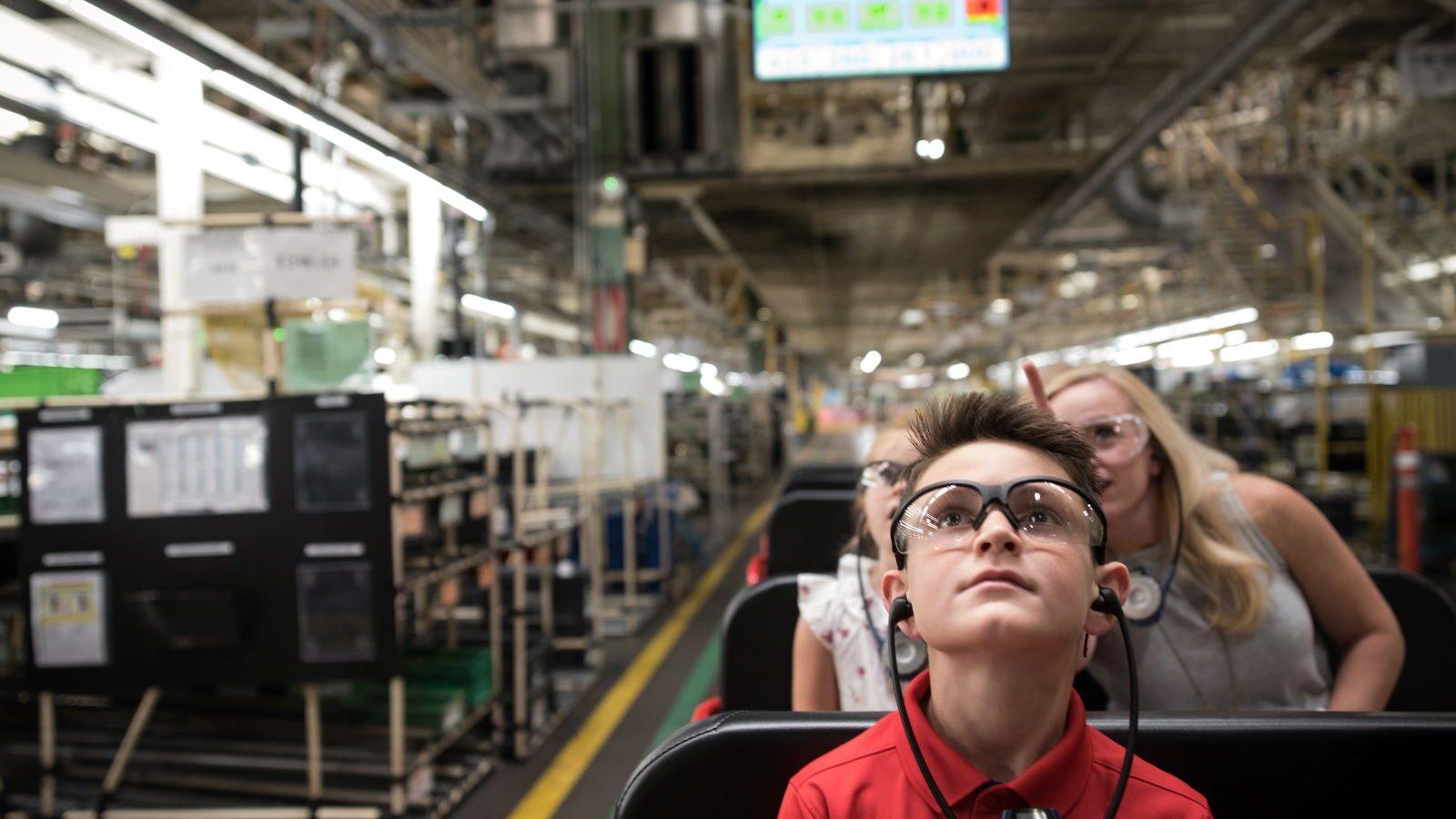
It’s finally here: MFG Day 2021!
Today The Manufacturing Institute, the NAM’s workforce development and education partner, officially kicks off the ninth annual day dedicated to inspiring the next generation of U.S. manufacturers.
Not just a day: Despite its name, the initiative will in fact run the entire month of October, and will feature nationwide, manufacturer-planned events aimed at giving students, parents and educators the chance to tour manufacturing facilities both virtually and in person.
- Events include factory tours, expos, open hours, job fairs and community gatherings—you can find a complete list here.
- Currently, there are more than 400 events registered on the MI website. Find out what’s happening in your area and sign up today!
Why it matters: As of July, the manufacturing industry had close to 900,000 open jobs, according to the Bureau of Labor Statistics. If the trend continues, this deficit could grow to 2.1 million by 2030, according to a recent study by the MI and Deloitte. It’s never been more urgent to get people interested in rewarding, lifelong manufacturing careers—for their own sake and the country’s.
- The matter is of such importance that President Biden issued a proclamation declaring October 1 National Manufacturing Day, calling it a day on which “we … recognize the importance of our Nation’s manufacturers to every aspect of our lives.”
What you can do: The MI has a host of resources for those of you who want to spread the word and get involved. These include:
- Resources for students: The MI has unveiled a website for future creators, the students who might be considering manufacturing careers. Check it out or pass it on to a student you know.
- Resources for manufacturers: Manufacturers who are currently planning an event, or considering one for later this year, we’ve got you covered! Check out this library of planning resources, including recordings of our four-part MFG Day planning series.
- Become a sponsor: If you can’t host this year, why not sponsor the effort? View this year’s prospectus to learn more about how you can become an MFG Day sponsor and receive additional support.
And don’t forget Creators Wanted! The Creators Wanted immersive experience also launches this month, with its first tour stop in Columbus, Ohio coming next week. It will be open from October 4 to 7 at Mitchell Hall at Columbus State Community College. And don’t worry; the experience will take place under stringent COVID-19 safety protocols.
- At the mobile experience, you’ll be able to enter an Escape Room-like challenge; get hands-on with technology demonstrations; meet creators who are making a difference and excited to share their career experiences; and access exclusive resources for manufacturing career pathways.
- Reserve your own spot or get some for young people of your acquaintance here.
The last word: As MI Executive Director Carolyn Lee says, “MFG Day provides manufacturers from coast to coast the opportunity to open their doors and highlight the work of the people who make things in America, which will help us recruit skilled talent and reach next-generation manufacturing employees.” In other words—don’t miss it!
The NAM Talks to the Fed
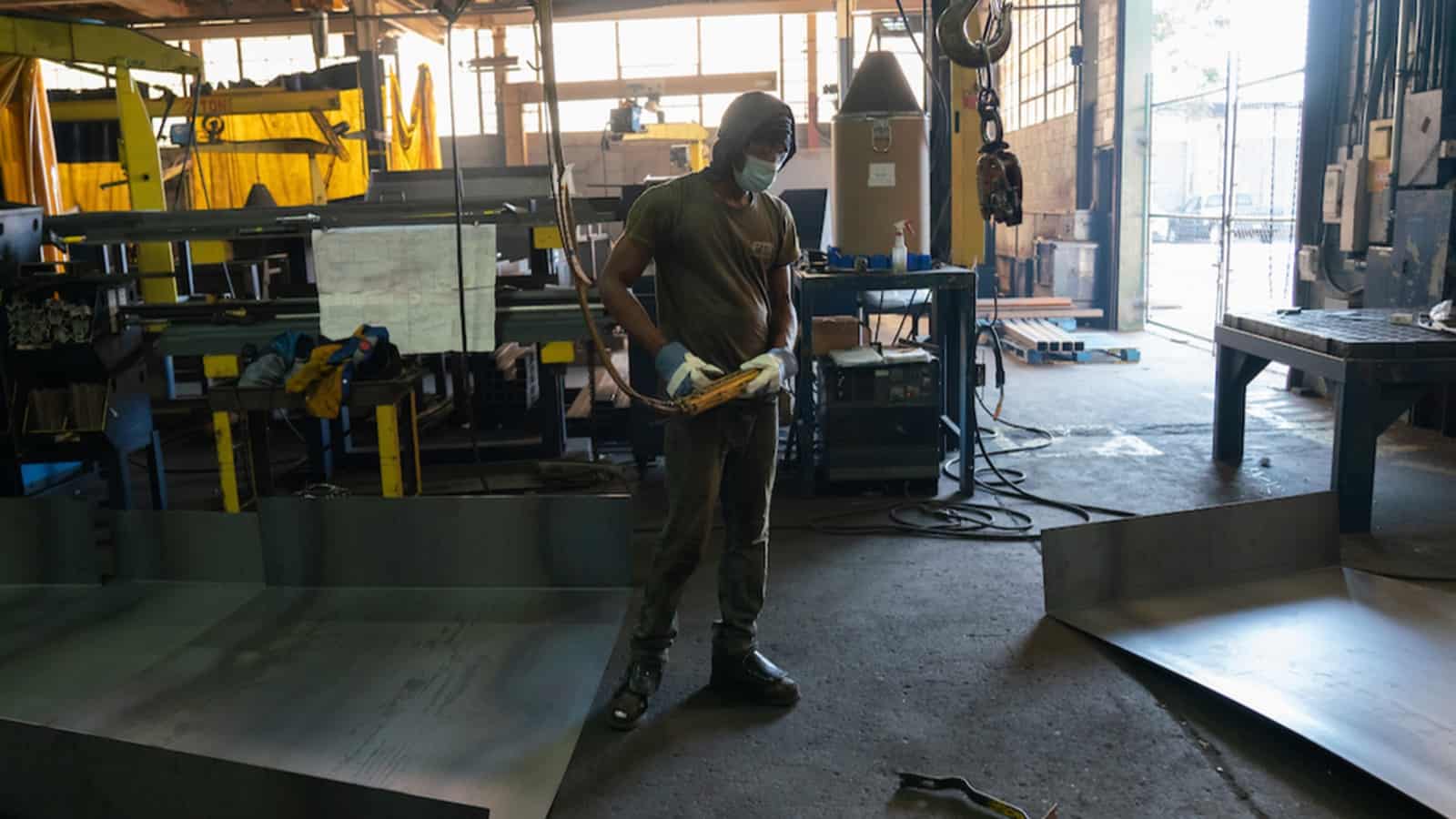
Manufacturing is the engine of U.S. economic growth. That’s why, when the Federal Reserve Board hosted a virtual Fed Listens event to discuss the economic recovery from the COVID-19 pandemic, it asked NAM Chief Economist Chad Moutray to share his perspective.
In his remarks, Moutray gave an overview of activity in the manufacturing sector and laid out his expectations for the road ahead. Here are some of the highlights.
A positive outlook: “Manufacturers are experiencing very strong demand as the U.S. and global economy recovers from the steep declines in activity seen last year at the beginning of COVID-19,” said Moutray. “Indeed, the most recent NAM Manufacturers’ Outlook Survey found that 87.5% of respondents were positive about their company’s outlook, which—while down from the three-year high seen in June—remained a healthy figure.”
Concerns on the horizon: “At the same time, manufacturing leaders cited rising raw material costs as their top concern for the third straight quarter, followed closely by challenges with attracting and retaining enough workers, with supply chain disruptions, and with logistics and transportation issues,” said Moutray. “Interestingly, 81.5% of those completing the survey said that workforce shortages were the biggest downside risk to their economic forecast, closely followed by supply chain disruptions, increased cost pressures and the continued spread of COVID-19, including the delta variant.”
Supply chain struggles: “While manufacturing growth remains solid, supply chain bottlenecks are significant, holding back even stronger expansions in the sector,” said Moutray. “Manufacturers continue to cite the backlog of cargo at the ports, the shortage of truck drivers and soaring shipping costs as significant impediments. In a just-in-time production environment, this poses a serious challenge to production and capacity—and the shortage of workers is not helping either.”
A look ahead: “These supply chain and logistics issues are likely to extend into at least the first half of 2022, at least based on my conversations with manufacturing executives,” said Moutray. “While pricing pressures are likely to stabilize as we move into 2022—assisted by a more-favorable base comparison—it is also clear that some costs will remain elevated relative to pre-pandemic levels, and core inflation might run hotter than we had become accustomed to.”
Dive Deeper: Read more about the economic outlook in the NAM’s 2021 3rd Quarter Manufacturers’ Outlook Survey.
JBM Packaging Is the Place for Second Chances
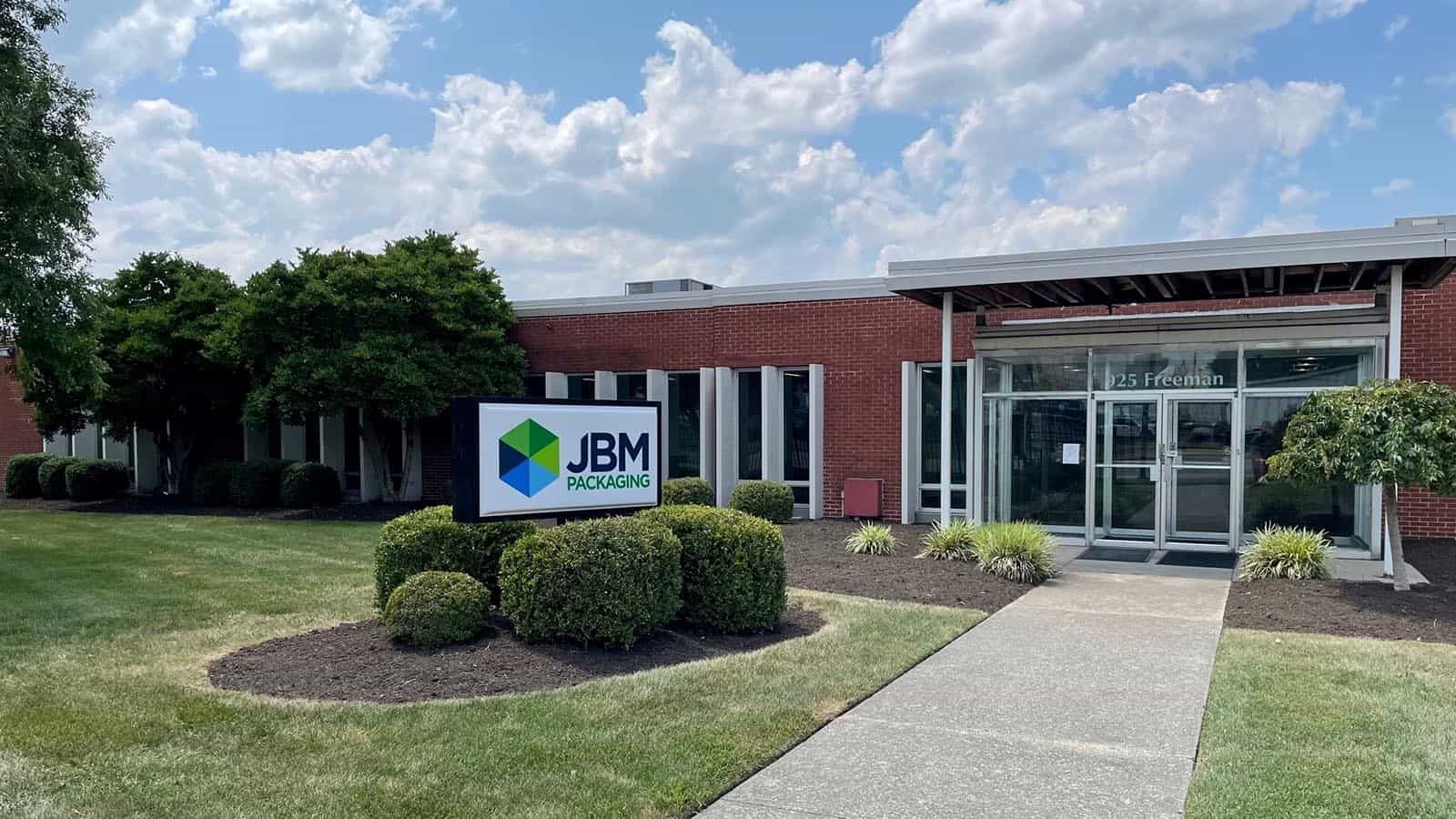
One day last year, when schools were closed due to the pandemic, President and CEO Marcus Sheanshang brought his kids to work with him at JBM Packaging of Lebanon, Ohio. And he knew exactly who should train the kids on the company’s envelope and packaging machines: Amanda Hall, one of the company’s star employees.
But Hall isn’t just a star; she’s a star with an unusual background. As Sheanshang put it, “We were having dinner that night, and I said to the kids, ‘Do you know something very interesting about Ms. Amanda? … Ms. Amanda was in prison a few years ago.’ They said, ‘No, there’s no way.’ They wouldn’t believe me.”
A factory for fair chances: In fact, Hall’s story is almost the rule, not the exception, for JBM. One-quarter of JBM’s employees are what the company calls “fair chance” hires, or those who have been involved with the criminal-justice system. Sheanshang expects that proportion to grow to half the workforce in the coming years.
How it began: Sheanshang instituted the hiring program, in which the company actively recruits future employees from 30 correctional institutions and halfway houses, about five years ago when looking for creative strategies to address labor shortages.
- “We don’t have people applying for jobs,” Sheanshang said, referring to the manufacturing industry’s long-time struggle to find enough skilled employees. “Fair chance hiring really plugged that hole for us and allowed us to grow and get the right team members on our team who share our values. When they get out of prison, they have a spot here at JBM.”
How it works: While JBM won’t bring on anyone who has been charged with sex crimes, crimes against women or crimes against children, the company is committed to hiring and supporting all others who want and are eligible to work.
- JBM has an on-staff change coach who works with all JBM employees to help them find housing, purchase a car and more. Her success with the employees has been so profound that JBM is looking to hire another such coach, Sheanshang told us.
Grand opening: In July, the packaging business opened a second plant, this one in downtown Cincinnati. While the company’s success made this expansion possible, JBM was also aiming to move closer to its fair chance employees and potential new hires.
- “We noticed there’s a fair number of barriers in the Lebanon area [regarding] housing and transportation,” Sheanshang said. The downtown Cincinnati location offers more transportation resources “for folks looking to get back on their feet.”
Triumph over tragedy: Sheanshang is proud of the successes that fair chance employees have achieved. He shared the story of Brian, a fair chance hire who started out as a production worker and now is on the path to becoming a quality control supervisor. Another fair chance employee, Justin, also began at JBM at entry level. He is now on track to become a trainer of other employees.
- “This is not stuff that’s given to them,” Sheanshang said. “This is stuff that they’re earning.”
The last word: “I would say to any CEO or other business owner, really take a hard look at fair chance hiring,” Sheanshang said. “When it gets down to brass tacks, this is a great strategy. If you have the systems in place to help fair chance hires, this will work.”
The Manufacturing Institute recently launched its second chance hiring initiative, which helps companies recruit and retain individuals with criminal records, just as JBM does. Learn more about this initiative here.
Creators Wanted Tests New Mobile Experience
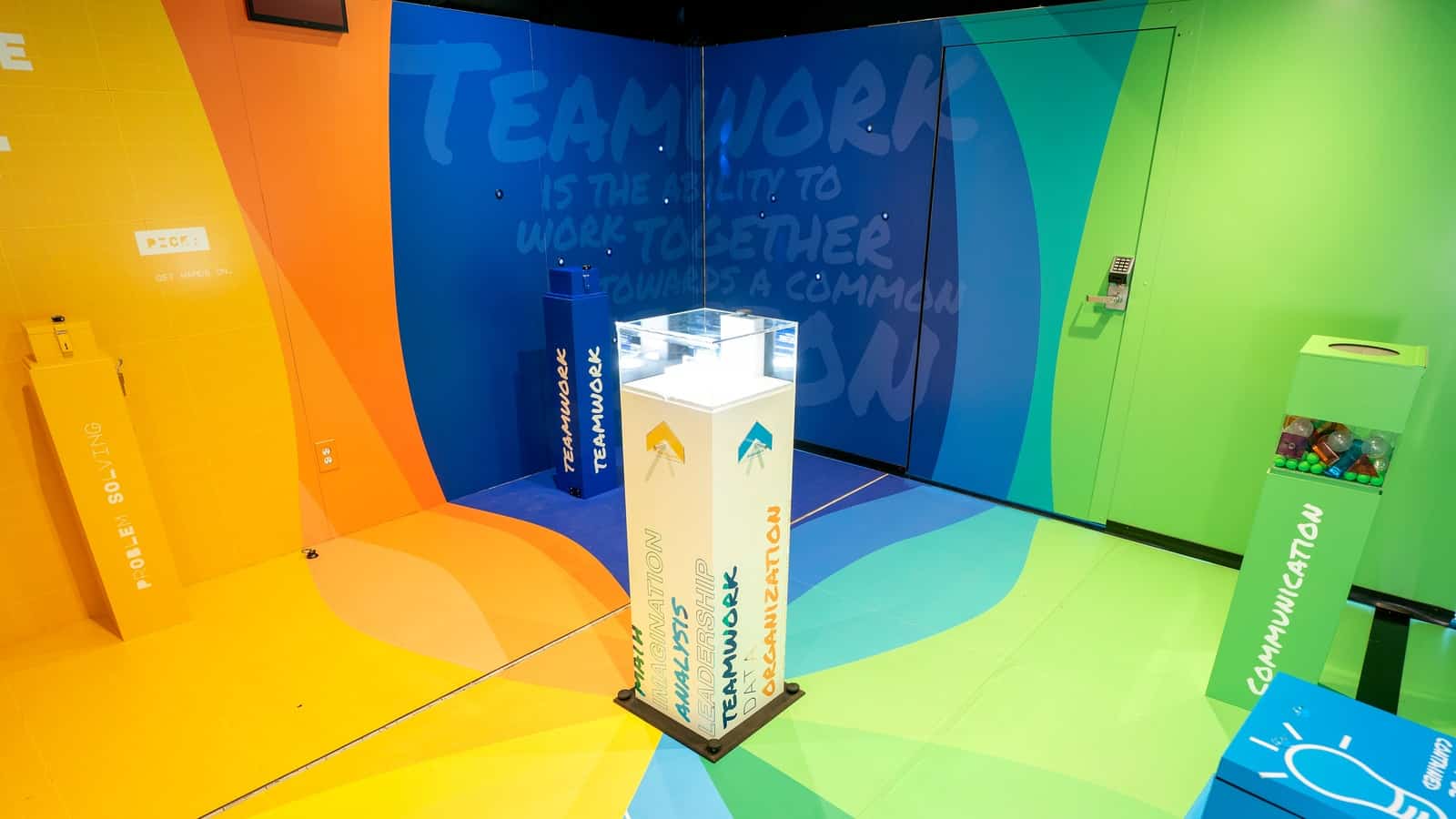
The NAM and The Manufacturing Institute took the Creators Wanted Mobile Experience for a test-drive in advance of a nationwide launch designed to inspire, educate and empower the next generation of creators.
What it is: The Creators Wanted Mobile Experience features an escape room mounted in a mobile unit, with a series of challenges intended to help bust myths around manufacturing and show young people and their parents the exciting opportunities available in the modern manufacturing industry. The program is designed to travel to schools and community centers nationwide.
What we did: The NAM and the MI brought three groups to Dallas, Texas, to test out the Creators Wanted Mobile Experience: students aged 15–17, students aged 18–22 and parents who have children aged 15–22. The groups first had conversations about career interests and perceptions of manufacturing, followed by a walk-through of the Creators Wanted Mobile Experience and another conversation about perceptions of manufacturing and career expectations.
What we learned: The Creators Wanted Mobile Experience completely changed participants’ view of the manufacturing industry, showing them the benefits of a career in modern manufacturing and making them excited about the opportunities manufacturing offers. While most participants had previously been skeptical about the industry’s ability to offer good, rewarding career paths, individuals who went through the Creators Wanted Mobile Experience came to appreciate manufacturing as an industry that offers diverse opportunities and workforces, high-end careers, competitive wages, job security, the chance to have an impact and careers that instill pride.
Our take: “We have a record of nearly 900,000 open jobs in modern manufacturing today, and 4 million jobs to fill, according to The Manufacturing Institute and Deloitte, by 2030,” said NAM Vice President of Brand Strategy Chrys Kefalas. “We knew we had to try something different to recruit and excite the next generation. We’re about to hit the next phase of our campaign to bring more of these rewarding opportunities to more people—and now we can be even more confident that we have the right approaches and messages to get the job done for manufacturers and for our country.”
Don’t take our word for it: Read the endorsement of the Creators Wanted campaign in The Dallas Morning News.
- “Creators Wanted is a clever approach that teens will enjoy. We encourage parents and guidance counselors to consider it. But the larger point here is about the pipeline of workers needed to ensure our economy can continue to grow. NAM has taken the initiative to improve that pipeline, putting them ahead of the competition for now. We hope to see others join that race soon.”
Want to get involved? Join this list of manufacturing leaders and companies supporting the campaign. Click here to get involved.
Still Leading the Way: Manufacturers Make Creators Wanted Live Possible
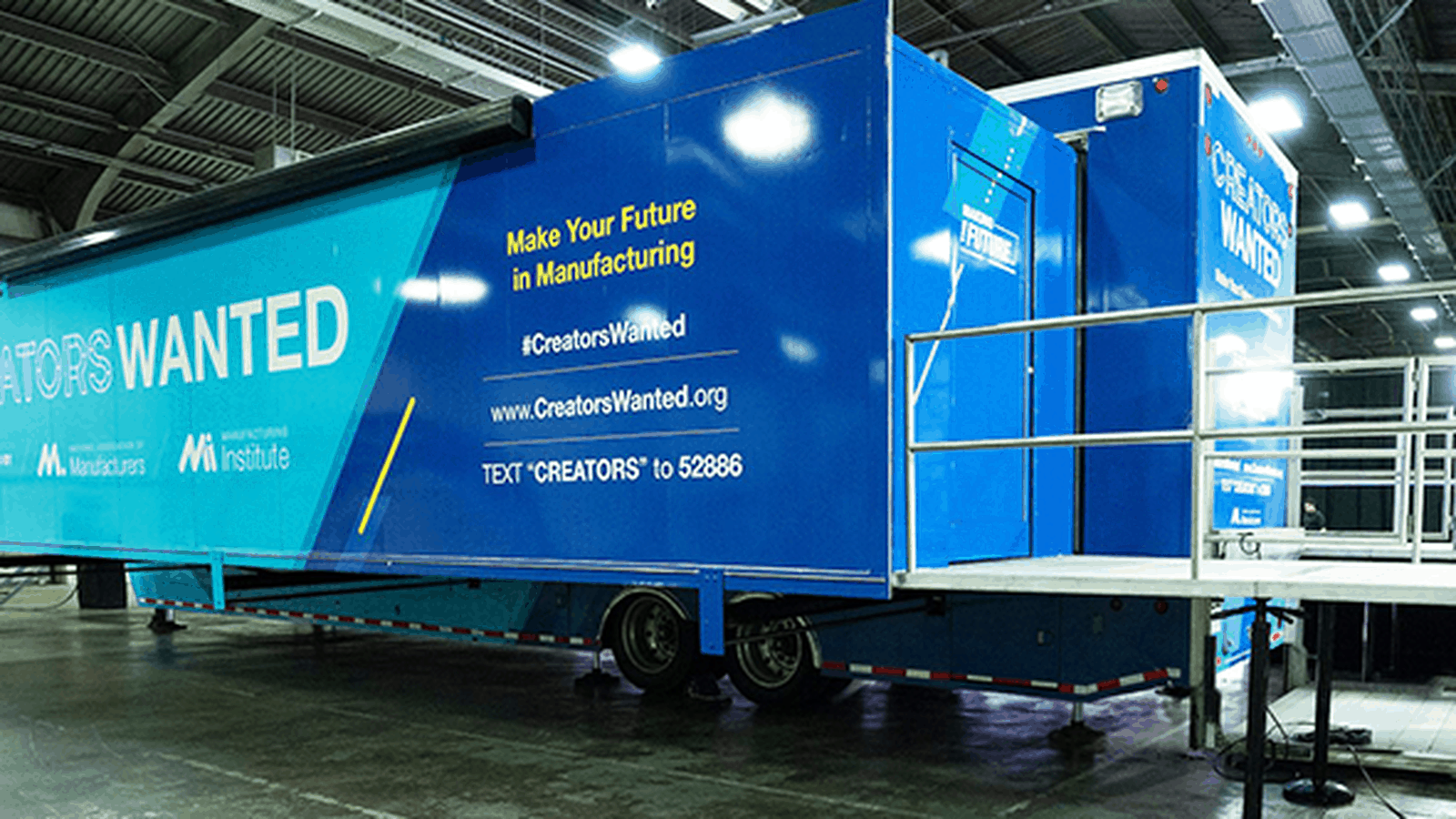
Through a global pandemic, manufacturers have led the way on health and safety measures, helping keep Americans working—for the U.S. and the world. Now the manufacturing industry continues that leadership while recruiting and inspiring the creators of the future.
On the road: Creators Wanted, the workforce campaign of the NAM and the MI, is getting ready to hit the road. The campaign formalized its COVID-19 safety protocols and is employing state-of-the-art technologies, like Sphere Synexis, provided by legacy sponsor Trane Technologies, to continuously fight viruses, bacteria and other hazards in the air and on surfaces. The mobile experience, along with other programming events and new online resources, will bring the story of modern manufacturing to communities across the country.
- The experience, recently endorsed by The Dallas Morning News, is designed to capture the imaginations of students, teachers and parents and inspire the next generation of manufacturers.
- It will complement the upcoming release of the NAM and MI’s innovative online resources for those seeking a career in manufacturing.
Coming to a town near you: The NAM and MI released the following Creators Wanted Live tour dates and stops.
- Oct. 4–7: Columbus, Ohio
- Oct. 12–15: Charlotte, North Carolina
- Oct. 20–22: West Columbia, South Carolina
- Nov. 8–10: Pella, Iowa
- Nov. 16–18: Freeport, Texas
- Nov. 30 – Dec. 3: Dallas, Texas
Wait, there’s more! Community programming stops are also coming to Detroit, Michigan; Guthrie, Kentucky; Pittsburgh, Pennsylvania; and Carson City, Nevada. And a new suite of digital and online experiences and tools will bring the campaign to every state.
Thanks to strong support: “Our ability to mount this bold solution to the workforce crisis through the difficulties of a pandemic has been anything but certain,” NAM President and CEO Jay Timmons and NAM Board Chair Mike Lamach said in a joint message to NAM membership. “It has taken the unwavering and strong support of some of America’s leading enterprises and business leaders to keep this campaign alive.”
See the full list of Creators Wanted sponsors here. Want to support the effort? Get involved—at any price point—here.
From a Small Farm to a Global Manufacturing Company: A STEP Honoree Story

Neha Phadke is a long way from home. Originally from a small farming village in India, Phadke grew sugar cane, onions, wheat and watermelon to support her seven-person family while she completed her bachelor’s degree. She moved to the United States to earn her Ph.D. in organic chemistry when Texas Tech University offered her full funding.
Today, Phadke works as a senior process chemist at Covestro, a high-tech polymer materials manufacturer that makes products used in industries including automotive, construction, health care, cosmetics, energy, electronics and sports. It’s her responsibility to find ways to improve production while maintaining quality.
Focused on manufacturing: Even when she was studying organic chemistry as an undergraduate and grad student, Phadke knew that she was more interested in applied science than academia. Near the end of her Ph.D. program in 2015, she received an internship opportunity at Covestro, which was then called Bayer Material Science. That internship turned into a job offer, and she has been working at Covestro ever since.
- “I was asked if I wanted to go into research and academia or manufacturing, and I was 100% sure I wanted to go into manufacturing,” said Phadke. “I had a feeling that this was where I belonged.”
Everything’s bigger in Texas: Still, Phadke faced a learning curve when she shifted from academia to manufacturing, including the scale of the work she was doing.
- “I had never seen big plants and reactors,” said Phadke. “I had worked on my Ph.D. in milligrams, and here I’m making more than 30,000 pounds of material in the reactors. It was fascinating, and I enjoyed the experience, process and learning through the new challenges.”
Standing up: Phadke may work in an environment that’s traditionally been male dominated, but she has never let that stop her before. Even when she was growing up, she knew that her ability to succeed should have nothing to do with her gender.
- “I was always asked if I had a sibling, and I would say I have a younger sister—and I would get sympathy for not having a brother,” said Phadke. “As a kid, I wouldn’t understand why it should make any difference. And it pushed me to think: why can’t I do anything a guy can do?”
Serving as an example: The Manufacturing Institute recently selected Phadke as a 2021 STEP Ahead Award Honoree—an honor given to women leaders who have excelled both within their companies and in the industry as a whole. She encourages other women to get involved in manufacturing and says that, while the industry might seem daunting, she’s gotten plenty of support from her colleagues and her company.
The last word: “Anything is possible,” said Phadke. “Don’t let anyone stop you from doing what you believe is right. Wear your courage, face your fears, lead your path, follow your passion and inspire others.”
Learn more about the STEP Ahead program, including how to honor remarkable women on your team, here.
How IPAK’s Diversity Sustained It Through COVID-19
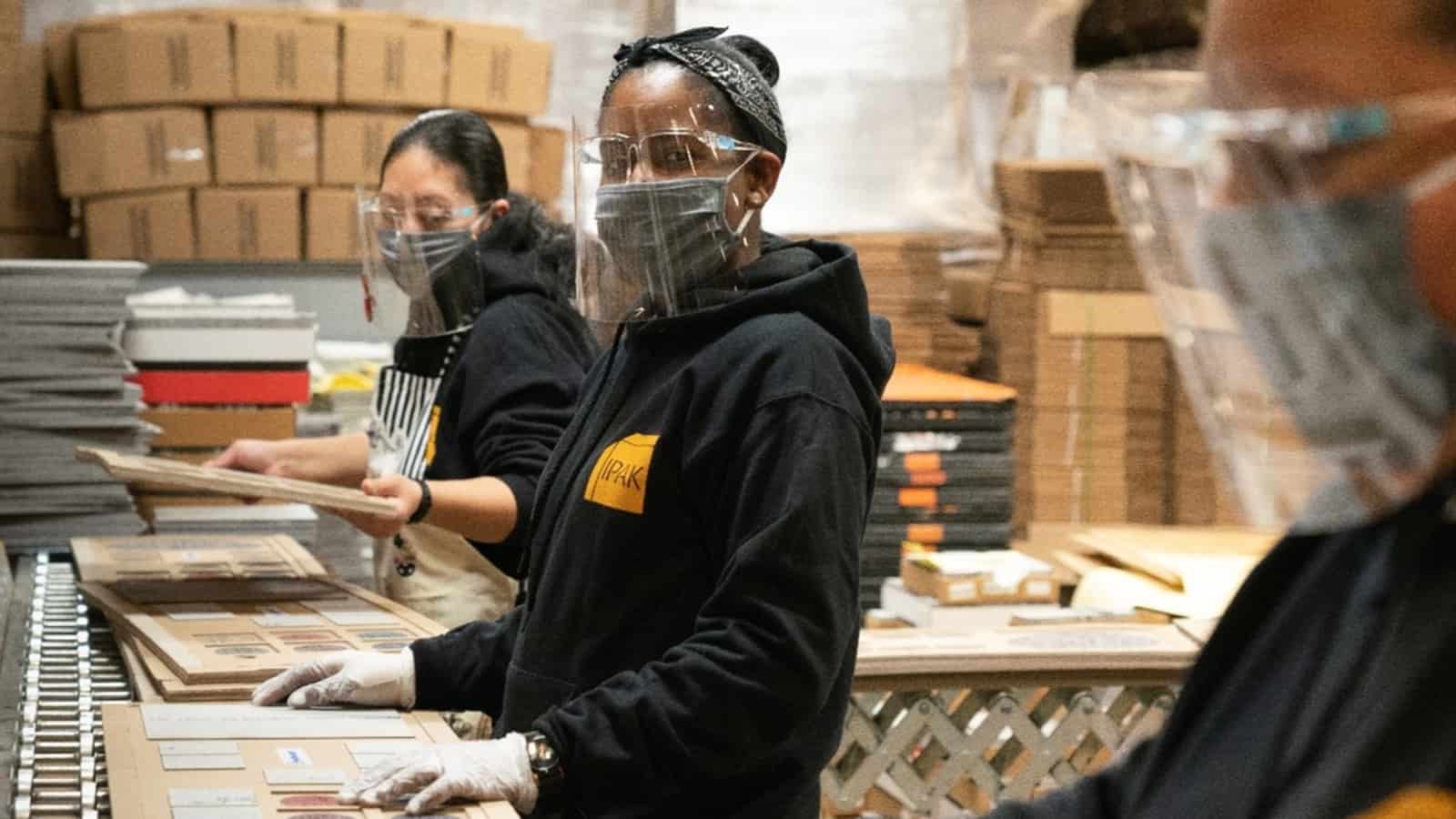
When COVID-19 swept through Camden, New Jersey, it hit the kit and packaging manufacturer IPAK very hard. The majority of IPAK’s nearly 100 employees are women and people from underserved communities, and like many other similarly situated groups, they suffered from particularly high case rates and economic disruption. But it was the company’s long commitment to diversity, equity and inclusion that helped it get through this global disaster—and even allowed it to thrive.
We spoke to IPAK CEO Karen Primak about all the company did to safeguard its employees and serve its customers. Here’s what she told us.
Keeping employees safe: The early days of the pandemic were terrible; the company had four employees in the hospital on respirators “right from the beginning,” says Primak. But IPAK responded swiftly and comprehensively:
- IPAK created an extensive COVID-19 action plan to prepare, inform and assist employees. This included an “ambassador” program so team members had a point of contact to ask about their virus-related concerns and receive answers and resources in the five different languages that employees speak.
- The company rearranged schedules to allow workers without childcare to be home when needed. Managers spent an hour or two every morning discussing how they could accommodate everyone.
- IPAK stayed current with the latest science and data, so that it could react quickly to the fast-changing pandemic. The company instituted an evolving set of daily cleaning protocols, social distancing measures, remote work provisions, masking and face shield requirements, vaccine information sessions and regular COVID-19 testing.
All these measures allowed IPAK to remain open and continue to deliver high-quality solutions to its customers throughout the pandemic. And here’s one last impressive detail: “We didn’t furlough or lay off anyone,” said Primak. “Despite all the craziness and the disproportionate impact on our employees and revenue, we remained committed to employing our workforce during this awful time.”
The “secret weapon”: How did IPAK cultivate the flexibility and dedication necessary to get through a global pandemic?
- “Diversity, equity and inclusion have been our secret weapon,” Primak said. “If you hire people like you, all you get back is you. IPAK is equipped with a range of voices and perspectives, which helps us innovate and creatively solve problems. Our commitment to put employees first and understand their needs allowed us to come together and stay operational during such a difficult time.”
Success during upheaval: IPAK also went above and beyond for its clients, including nonprofit educational-content provider ACT, maker of the well-known college-entrance exam, whose supply chain was upended by COVID-19.
- ACT was faced with shipping disruptions, shuttered test centers, constantly changing local conditions and testing center capacity constraints. It needed an agile partner who would be able to move quickly, adjust schedules and innovate in real time.
- As a result, ACT pivoted early in the pandemic and massively expanded its contract with IPAK to include the handling of secure paper-based processing, which includes creating kits and manufacturing and distributing the ACT test.
- Amid all this disruption and change, IPAK stepped up. Its staff worked tirelessly with ACT to deliver more than 2 million college-entrance exams during the pandemic.
“We worked nights and weekends and even hand-delivered some test booklets to make sure they arrived on time,” said Primak.
A great partnership: “We were the vendor that was willing to make huge and necessary changes alongside ACT during the pandemic so that many deserving students could take the ACT and benefit from the opportunities afforded by their hard work,” Primak said.
- “IPAK asked so many questions about our organization and offered a unique process optimization perspective,” said ACT CEO Janet Godwin. “It was clear they had deep knowledge of the education marketplace and cared about our mission—not just their bottom line. IPAK knocked its first assignment out of the park, catalyzing ACT to outsource additional critical programs to IPAK.”
NAM involvement: Primak also credits the NAM’s work with Congress and the administration with helping IPAK survive and succeed. She is grateful for government programs such as the employee retention tax credits, economic injury disaster loans and Paycheck Protection Program loans, which the NAM advocated for, and said that without such help, the company “wouldn’t be here.”
The last word: “Helping people achieve success and ensure equity, access and opportunity for all” is ACT’s mission, said Primak. It’s that type of commitment to equity and inclusion that also motivates IPAK’s whole team, in good times and in pandemics.
The NAM and The Manufacturing Institute are committed to increasing diversity and inclusion in the manufacturing industry. Visit the NAM Pledge for Action page to make your own commitment today.
